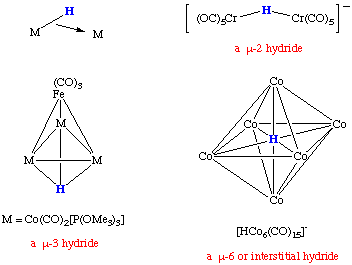
Hydride complexes contain a metal-hydrogen bond. The hydride ligand itself need not be hydridic in nature, but can in fact vary in nature from acidic to hydridic depending on the nature of the metal center to which it is attached. Species can have up to several hydride ligands; even [ReH9]2- is known! The hydride ligand is considered to be an anionic ligand.
Hydride ligands display a diverse array of bonding modes, a few of which are shown below. Metal complexes where the hydride ligands are terminal or bridging two metal centers are by far the most common bonding modes.
It should be noted that a bridging hydride does not contain a linear M-H-M angle. This can be rationalized by the bonding description shown here. Conceptually, a bridging hydride is a three-center two-electron bonding situation. We need not need to invoke a metal-metal bond in this description.

Hydrides can be made through a variety of methods:
Single crystal X-ray diffraction is not particularly useful for locating hydrides because the X-ray experiment depends on scattering by the electrons present in the molecule. The combination of hydrogen having only one electron, that electron being located between the metal and hydrogen and the large number of electrons in the metal makes it very difficult to "see" the hydride atom. In cases when it can be found by X-ray diffraction, the M-H distance is often underestimated by about 0.1 Angstrom.
Terminal M-H bonds are observed in the region of 1600 to 2250 cm-1 by infrared spectroscopy while M-H-M bonds are typically found in the region from 800 to 1600 cm-1. These stretches are sometimes weak, particularly with bridging species. In some cases, the stretch may be unobservable or coupled to another vibrational mode in the molecule. Preparation of the corresponding deuteride complex and comparison with the IR spectrum of the hydride is an excellent means of assigning the presence of a hydride ligand as these shifts can be predicted using a harmonic oscillator approach.
Hydrides are usually easy to see in the proton NMR as their proximity to the metal causes large shieldings or deshieldings. There can be problems observing hydrides when the molecule is fluxional or the hydride is attached to one or metal centers with large quadrapole moments. In general, low temperature investigations can get around these obstacles.
The chemical shift range for hydrides is approximately +25 to -60 ppm. The downfield shifts are most common in d0, d10 and early transition metal cases whereas those with other dn counts and late transition metals tend to be upfield of zero. Coupling to other spin active nuclei such as 31P often makes structural assignments unambiguous.